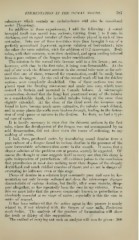Page 787 - My FlipBook
P. 787
FERMENTATION' IN THE HUMAN MOUTH. 797
substances which contain no carbohydrates Avill also be considered
under Pliysiology.
In addition to these experiments, I add the following A sound
:
bicuspid tooth was sawed into sections, varying from ^ to 1 mm. in
thickness, and an equal number of these sections placed in each of two
test-tubes. Into one of these test-tubes were then brought 5 c.c. of a
})erfectly neutralized 2-per-cent. aqueous solution of beef-extract ; into
the other the same solution, with the addition of 0.2 cane-sugar. Both
tubes, with their contents, were then sterilized, and upon cooling infected
from a pure culture of the fungus under consideration.
The solution in the second tube became acid in a few hours ; not so,
however, with that in the first tube, it being non-fermentable. At the
end of one week the thinner sections in the second tube were so far soft-
ened that one of them, removed for examination, could be easily bent
between the fingers. At the end of the second week all but the thicker
sections were completely decalcified. One of these sections was now
placed upon the freezing microtome and made into cuts, which were
stained in fuchsin and mounted in Canada balsam. A microscopic
examination showed that the fungi had penetrated many of the tubules
to a considerable de])th, the invaded tubules being at the same time
slightly extended. At the close of the third week the invasion was
found to have become much more extensive, the tubules much dilated,
and in some places the walls were broken through, leading to the forma-
tion of oval spaces or caverns in the dentine. In short, we had a typi-
cal case of caries.
It is hardly necessary to state that the thinnest sections in the first
tube, where the development of the fungus was not accompanied by an
acid fermentation, did not show even the traces of softening, to say
nothing of caries.
I had, then, produced caries by inoculating sound dentine from a
pure culture of a fungus found in carious dentine in the presence of the
same fermentable substances that occur in the mouth. It seems that a
clearer solution of the problem can at present scarcely be expected. Of
course the thought at once suggests itself to every one that this decay is
quite independent of putrefaction ; all evidence points to the conclusion
that putrefaction at most does nothing more than dispose of the already
devitalized and much riddled remains of tissue, and we are in danger of
overrating its influence even at this stage.
Pieces of dentine in a solution kept constantly pure and sour by fer-
mentation not only become softened and show the microscopic changes
characteristic of carious dentine, but finally, after some months, disap-
pear altogether, as has repeatedly been the case in my cultures. From
this we must infer that the process commonly known as putrefaction is
absolutely essential at no stage of caries ; especially is this the case in
caries of enamel.
It has been intimated that the active agent in this process is nearly
related to, if not identical with, the fungus of sour milk. Bacterium
nckli lactici. The analysis of the product of fermentation will show
the truth or falsity of this supposition.
The method of carrying out such an analysis wall now be given : 200


